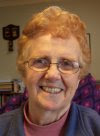There Was an Old Sailor
Written by Claire Saxby
Illustrated by Cassandra Allen
Published by Walker Books Australia 2010
Today I am talking to Claire Saxby, author, about her newly released picture book, There Was an Old Sailor. Our discussion focuses on Rhyme, Rhythm and Reason.
. . . . . . . . . . . . ‘With a wish and a swish
. . . . . . . . . . . . .he swallowed a fish’
Claire: Hello Mabel. Thanks for hosting me
Mabel: Do you find it fascinating that children begin with rhyme and rhythm; even before they can talk ... as though our ears and brains are hard-wired from birth to sound and repetition?
Claire: Children's language development is nothing short of astounding. It's such a treat to watch as they play with sounds and shape words. I watched a program that looked at children all around the world learning to speak. One comment was that they experiment with their own grammar, rather than just learn by parroting what they hear. eg my ....is betterer than... using grammar forms that don't exist. That's stuck with me, that idea that they have some innate sense of language, not just copying.
Mabel: Would you like to comment on the connections between rhyme and rhythm (poetry, if you like) and magic; poetry and magic?
Claire: Yes, poetry is magic! I like that it can say more with less, that it can open up images in fresh new ways, can paint pictures with words. Rhythm is essential in poetry, as it is in any writing really. The best rhythm allows any reader to read without stumbling.
Mabel: Rhyme has been called a kind of musical punctuation. Is that how you see it?
Claire: Rhyming is hard. Hard to do really well. So generally I avoid it! But the structure was already there for 'There Was an Old Sailor', and I enjoyed the playing with rhyme. Musical punctuation? I joined a choir about a year ago and have been challenged by reading music and reading the breaks. I'd not thought of rhyme that way. I like the idea though.
Mabel: Is rhyme important for pre-readers and beginning readers?
Claire: Rhyme is a great tool for learning. It can help pre- and beginning readers to access language by linking the familiar to the unfamiliar, or just by making words fun.
Mabel: The dictionary defines rhythm as ‘a movement with uniform occurrence of a beat or accent’ - or if you like a pulse that provides a distinct beat and gives shape. Did you feel that as you were writing this book?
Claire: I am very aware of rhythm when I write. I read my work out loud and also get others to read it out loud. This helps me to refine the text and improve the rhythm. Early drafts are about shaping story and working out beginning, middle and end, but later ones are about tweaking and rearranging the words to make them sing.
Mabel: Do you agree that rhyme, rhythm and reason are the three great ‘R’s of storytelling that help maintain the connection with an audience or reader?
Claire: I don't pretend to be a skilled oral storyteller, but I do have a close friend who is mesmerising to listen to. I've learned a lot about reading my stories aloud, and about writing them from listening to her tell stories. She shares stories from all over the world, and all contain the elements you mention. I certainly aspire to pull in the reader and keep them there!
Mabel: Tell me a little about the role of humour in this story. Is it more than a celebration of rhyme and tomfoolery?
Claire: It's an absurd story! Very silly really. But it still makes a silly-sense. When I use the story as a workshop frame in classrooms I talk about the need to use 'silly-sense'. The story must keep moving forward and build to a climax. So there are logical elements e.g., in that each sea creature is larger than the previous one.
Mabel: And that bigger and bigger surely creates a wonderful picture book! Thankyou, Claire for sharing your insights. I’ve really enjoyed being part of this book’s blog tour. Where are you off to tomorrow?
Claire: I’ll be with Sandy Fussell at . Hope to see you there.
For readers who wish to visit or revisit them, the schedule of all the stops is listed below!
Mon 8 February: Sally Murphy's Writing for Children http://www.sallymurphy.blogspot.com/
Tues 9 February: Dee White's Tuesday Writing Tips http://deescribewriting.wordpress.com/Wed 10 February: Dale Harcombe's Read and Write with Dale http://www.livejournal.com/users/orangedale/
Thurs 11 February: Robyn Opie's Writing Children's books http://www.robynopie.blogspot.com/
Fri 12 February: Lorraine Marwood's Words into Writing http://lorrainemarwoodwordsintowriting.blogspot.com/
Sat 13 February: Mabel Kaplan's Tales I Tell http://belka37.blogspot.com/ [You are here!]
Sun 14 February: Sandy Fussell's Stories are Light http://sandyfussell.blogspot.com/









Thanks for hosting me here!
ReplyDeleteClaire
Finally catching up with the tour. It's really interesting to read such a different picture book interview. I feel like I've learned something.
ReplyDeleteMusical punctuation? Great phrase Mabel!
ReplyDeleteThanks ladies for anotehr great interview.
Thank you, Claire, Sandy an Sally for dropping by.
ReplyDeleteI do enjoy setting up creative blog interviews.